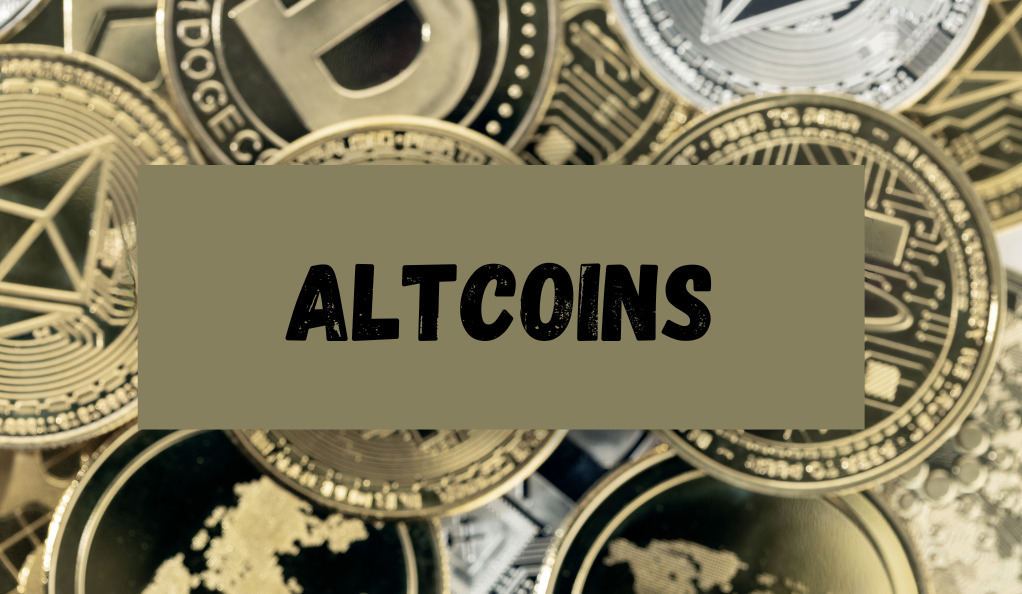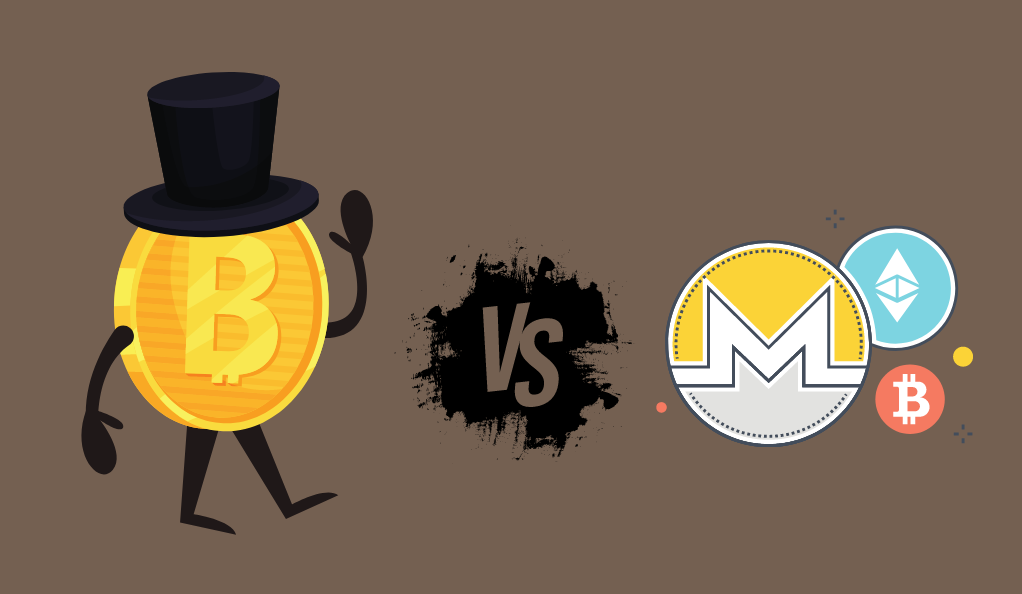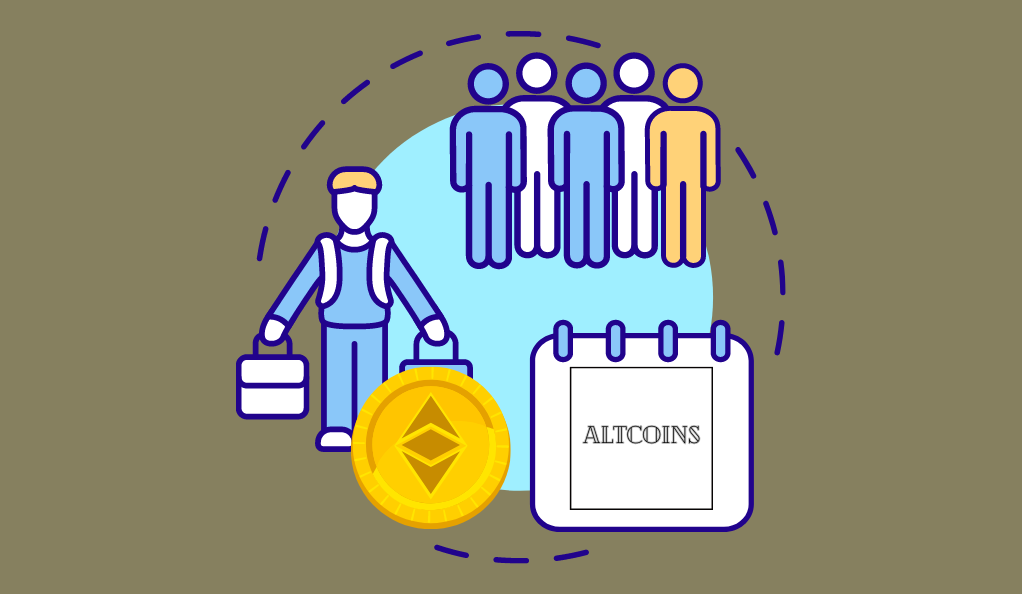In the realm of digital finance, cryptocurrencies have sparked a revolutionary shift, with Bitcoin leading the charge as the pioneer. However, beyond the towering presence of Bitcoin, lies a diverse ecosystem of alternative cryptocurrencies, commonly referred to as “altcoins.” In this exploration, we delve into the captivating world of altcoins, understanding their origins, significance, and how they differ from the original cryptocurrency.
Origins and Significance of Altcoins:

Altcoins, an amalgamation of “alt” (short for “alternative”) and “coin” (symbolizing cryptocurrency), encompass all digital coins that are not Bitcoin. The inception of altcoins followed the emergence of Bitcoin itself, driven by the desire to address its technical limitations and explore new possibilities. While Bitcoin’s groundbreaking introduction of blockchain technology redefined finance after the global financial crisis of 2008-09, it was not without its challenges. These challenges led to the creation of alternative cryptocurrencies that aimed to build upon Bitcoin’s foundation.
Diverse Functions and Goals:
Unlike Bitcoin, which primarily functions as a digital currency and store of value, altcoins are diverse in their functions and objectives. Some altcoins aim to enhance transaction speed and scalability, while others focus on enabling smart contracts and decentralized applications. This diversity has birthed a multitude of altcoins, each with its unique value proposition and vision for reshaping the digital landscape.
Key Differences Between Altcoins and Bitcoin:
Altcoins differentiate themselves from Bitcoin through a range of features and mechanisms. These differences include consensus mechanisms, block generation times, supply limits, and hashing algorithms. For instance, Litecoin (LTC) introduced the “scrypt” algorithm to enhance transaction speed compared to Bitcoin’s “SHA-256.” Ethereum (ETH), on the other hand, introduced the concept of smart contracts, enabling the creation of decentralized applications on its blockchain.
Comparison Table: Altcoins vs. Bitcoin:
| Aspect | Bitcoin | Altcoins |
|---|---|---|
| Consensus Method | Proof-of-Work (PoW) | Various methods (PoW, PoS, DPoS, etc.) |
| Block Generation | About 10 minutes | Varies (2.5 minutes for Litecoin) |
| Supply Limit | Capped at 21 million BTC | Varies (e.g., 84 million LTC) |
| Functionality | Currency and store of value | Diverse functions and use cases |
| Hashing Algorithm | SHA-256 | Various algorithms (e.g., scrypt) |
Exploring Altcoin Categories:
Altcoins encompass a range of categories, each designed to cater to specific needs and use cases. Some of these categories include:
- Proof-of-Work (PoW) Altcoins: Similar to Bitcoin, these altcoins validate transactions through computational puzzles.
- Proof-of-Stake (PoS) Altcoins: Transactions are verified based on the amount of cryptocurrency held by validators.
- Stablecoins: Tethered to fiat currencies, providing stability and ease of use for transactions.
- Decentralized Finance (DeFi) Altcoins: Enabling decentralized lending, borrowing, and financial services.
The Birth and Evolution of Altcoins: Unveiling Second and Third-Generation Cryptocurrencies
The Rise of Second and Third-Generation Cryptocurrencies:
While Bitcoin pioneered the concept of a decentralized, blockchain-based digital currency, its limitations sparked the quest for more sophisticated solutions. Enter second and third-generation cryptocurrencies, designed to address the challenges that Bitcoin encountered.
Second-Generation Cryptocurrencies:
The emergence of second-generation cryptocurrencies marked a significant step forward in the evolution of digital finance. These altcoins sought to enhance Bitcoin’s technical shortcomings, such as transaction speed and scalability. Litecoin (LTC), often referred to as “silver to Bitcoin’s gold,” introduced a scrypt hashing algorithm that enabled faster block generation. This advancement facilitated quicker transactions and improved network efficiency, paving the way for digital currencies that were not solely focused on being stores of value.
Third-Generation Cryptocurrencies:
The third-generation of cryptocurrencies ventured beyond transaction speed and scalability, delving into revolutionary capabilities like smart contracts and decentralized applications. Ethereum (ETH) emerged as a trailblazer, introducing the concept of a decentralized virtual machine capable of executing programmable smart contracts. This innovation catalyzed the development of decentralized applications (dApps) that could revolutionize industries beyond finance.
Pricing and Valuation in Comparison to Bitcoin:
The valuation of altcoins in comparison to Bitcoin is a dynamic interplay influenced by a variety of factors. Historically, altcoins have been priced in terms of Bitcoin, showcasing their relative value within the cryptocurrency ecosystem.
While Bitcoin’s market dominance has remained robust, altcoins have carved out their niches, with some presenting unique value propositions that drive demand. The pricing of altcoins is often a reflection of their utility, adoption, and technological innovation. As the crypto market matures, some altcoins have witnessed remarkable price surges, sparking debates about the potential diversification of investment portfolios beyond Bitcoin.
Types of Altcoins: Unveiling the Diversity of Cryptocurrency Categories
Proof-of-Work (PoW) and Proof-of-Stake (PoS) Altcoins:
Cryptocurrencies rely on consensus mechanisms to validate and record transactions on their respective blockchains. Two of the most prominent mechanisms are Proof-of-Work (PoW) and Proof-of-Stake (PoS).
PoW Altcoins:
This category includes cryptocurrencies that employ the PoW mechanism, pioneered by Bitcoin. Miners solve complex mathematical puzzles to validate transactions and add blocks to the blockchain. Examples of PoW altcoins include Litecoin (LTC), Bitcoin Cash (BCH), and Zcash (ZEC).
PoS Altcoins:
In contrast, PoS altcoins operate on a different principle. Validators are chosen based on the amount of cryptocurrency they hold and are willing to “stake” as collateral. This mechanism reduces the energy consumption associated with mining. Ethereum, a prominent PoW cryptocurrency, is transitioning to a PoS mechanism with Ethereum 2.0. Notable PoS altcoins include Cosmos (ATOM) and Tron (TRX).
Stablecoins: The Bridge Between Fiat and Crypto:
Volatility has been a significant concern in the world of cryptocurrencies. Stablecoins address this challenge by pegging their value to a stable asset, often a fiat currency like the US Dollar (USD).
Stablecoins offer a seamless bridge between the worlds of traditional finance and cryptocurrency. Tether (USDT), for instance, maintains a 1:1 peg to the USD. These coins facilitate smoother transactions and enable users to store value without being exposed to the volatility commonly associated with other cryptocurrencies.
Decentralized Finance (DeFi) Altcoins:
Decentralized Finance (DeFi) represents a revolutionary movement that aims to transform traditional financial systems using blockchain technology. DeFi altcoins play a pivotal role in this ecosystem, enabling activities such as lending, borrowing, trading, and yield farming, all without the need for intermediaries.
DeFi Stablecoins:
Stablecoins have found a significant use case within DeFi, allowing users to transact and participate in the ecosystem without being affected by the price fluctuations of traditional cryptocurrencies.
DeFi Tokens:
Tokens like Compound (COMP), Aave (AAVE), and Uniswap (UNI) power DeFi platforms. They often provide governance rights, allowing holders to participate in decision-making regarding protocol upgrades and changes.
Key Differences Between Popular Altcoins and Bitcoin: Unveiling Distinctive Features

As the cryptocurrency universe expands, various altcoins have emerged, each with its unique features and value propositions. These differences distinguish them from the original cryptocurrency, Bitcoin. In this exploration, we delve into the key distinctions between Bitcoin and four popular altcoins: Litecoin, Ethereum, Bitcoin Cash, and ZCash.
Litecoin vs. Bitcoin: Speed and Scalability:
One of the earliest altcoins, Litecoin, was created by Charlie Lee in 2011 as the “silver to Bitcoin’s gold.” Litecoin aimed to address Bitcoin’s limitations, particularly in terms of transaction speed and scalability.
- Transaction Speed: Litecoin employs a different hashing algorithm (scrypt) that allows for faster block generation compared to Bitcoin’s SHA-256 algorithm. This results in quicker transaction confirmations.
- Scalability: The faster block generation and adoption of the Lightning Network have positioned Litecoin as a more scalable cryptocurrency for daily transactions.
Ethereum vs. Bitcoin: Functionality and Smart Contracts:
Ethereum, introduced by Vitalik Buterin in 2015, took the concept of blockchain technology beyond digital currency, enabling the creation of decentralized applications (dApps) through smart contracts.
- Functionality: While Bitcoin primarily serves as a digital currency, Ethereum is a platform that supports a wide range of applications beyond transactions.
- Smart Contracts: Ethereum’s smart contract capabilities allow developers to code and execute self-executing contracts, automating complex tasks without intermediaries.
Bitcoin Cash vs. Bitcoin: Transaction Efficiency:
Bitcoin Cash emerged in 2017 as a result of a hard fork from the Bitcoin blockchain. It aimed to address Bitcoin’s scalability issues by increasing the block size limit.
- Block Size: Bitcoin Cash has a larger block size compared to Bitcoin, which allows for more transactions to be included in each block. This enhances transaction throughput and reduces congestion.
- Transaction Fees: The larger block size and increased transaction capacity have led to lower transaction fees on the Bitcoin Cash network, making it more cost-effective for smaller transactions.
ZCash vs. Bitcoin: Enhancing Anonymity:
ZCash, launched in 2016, focuses on enhancing privacy and anonymity in cryptocurrency transactions, a feature that sets it apart from Bitcoin.
- Privacy Features: ZCash employs zero-knowledge proofs (zk-SNARKs) to enable private transactions. Unlike Bitcoin, where all transaction details are visible on the blockchain, ZCash allows users to shield transaction amounts and participant identities.
- Selective Transparency: ZCash offers selective transparency, giving users the option to disclose transaction details when necessary, such as for regulatory compliance.
How to Buy and Store Altcoins: Navigating the Path to Altcoin Investment
Steps to Invest in Altcoins:
- Research and Choose Altcoins: Begin by researching different altcoins to identify those that align with your investment goals and values. Evaluate factors such as technology, use cases, and market potential.
- Select a Cryptocurrency Exchange: Choose a reputable cryptocurrency exchange where you can purchase altcoins. Popular exchanges include Coinbase, Binance, and Kraken.
- Create an Account: Sign up for an account on the chosen exchange. Provide necessary identification documents for verification purposes.
- Deposit Funds: Deposit funds into your exchange account using fiat currency (e.g., USD, EUR) or other cryptocurrencies.
- Place an Order: Once your funds are deposited, place an order to buy the desired altcoins. You can use market orders for immediate purchase or limit orders to set a specific price.
- Execute the Purchase: When the price matches your order, the purchase is executed, and the altcoins are credited to your exchange account.
- Consider a Wallet: While exchanges provide convenience, it’s advisable to transfer your altcoins to a secure wallet for enhanced security.
Importance of Crypto Wallets:
Crypto wallets play a pivotal role in ensuring the security of your digital assets. While exchanges provide a platform for buying, selling, and trading cryptocurrencies, they are vulnerable to hacking and security breaches. Here’s why crypto wallets are crucial:
- Enhanced Security: Wallets store your private keys offline, minimizing the risk of online attacks and hacks that target exchanges.
- Control and Ownership: With a wallet, you have complete control over your altcoins. Your assets are not held by a third party, reducing counterparty risk.
- Protection Against Exchange Issues: In the event of exchange downtime or closure, your altcoins stored in a wallet remain unaffected.
- Various Wallet Options: Choose between hardware wallets (physical devices), software wallets (desktop or mobile apps), and web wallets (online platforms).
- Backup and Recovery: Most wallets allow you to create backups, ensuring that you can recover your assets even if the wallet is lost or damaged.
The Phenomenon of Altcoin Season: Unveiling the Rise of Alternative Cryptocurrencies

Definition and Historical Context:
Altcoin season refers to a specific phase in the cryptocurrency market cycle during which altcoins experience significant price appreciation and heightened market activity. This phenomenon contrasts with periods when Bitcoin’s dominance takes center stage, often referred to as “Bitcoin dominance” phases.
Historically, altcoin seasons have occurred in cycles, coinciding with shifts in market sentiment and investor behavior. These cycles tend to follow the momentum of Bitcoin’s price movements but amplify the gains of altcoins.
Factors Leading to an Altcoin Season:
Several factors contribute to the emergence of altcoin seasons, ushering in a period of increased altcoin activity and value appreciation:
- Bitcoin’s Price Stability: When Bitcoin’s price stabilizes or enters a consolidation phase, investors seek opportunities in altcoins with the potential for higher short-term gains.
- Market Sentiment: Positive sentiment in the cryptocurrency community, driven by technological advancements or adoption milestones, can spark interest and investment in altcoins.
- Speculative Interest: Traders and investors seeking rapid gains often turn to altcoins during periods of positive sentiment, driving demand and increasing prices.
- Innovations and Upgrades: Technological developments within specific altcoin projects, such as protocol upgrades or partnerships, can generate excitement and attract investment.
- Diversification: Investors diversify their portfolios to manage risk. Altcoins offer unique value propositions beyond Bitcoin, making them attractive options for diversification.
- Media Attention: Media coverage and news related to specific altcoin projects can lead to increased awareness and interest among investors.
- Market Maturity: As the cryptocurrency market matures, more projects with real-world use cases and adoption potential emerge, drawing attention away from Bitcoin dominance.
The Future Landscape of Altcoins
Potential for Diversification in Investment Portfolios:
Altcoins offer investors the opportunity to diversify their cryptocurrency portfolios beyond Bitcoin. While Bitcoin remains a cornerstone of the digital asset market, altcoins provide exposure to a wide range of technological innovations and use cases.
Risk Mitigation:
Diversifying into altcoins can mitigate risk by reducing over-dependence on a single cryptocurrency and providing exposure to different market segments.
Technological Innovation:
Many altcoins introduce novel technologies and functionalities that can drive future market growth. These innovations may include enhanced privacy features, scalability solutions, and smart contract capabilities.
The Survival of Altcoins with Strong Use-Cases:
As the cryptocurrency market matures, the survival of altcoins is contingent on their ability to deliver real-world value and address specific pain points. Altcoins with strong use-cases are more likely to stand the test of time.
Innovation and Adoption:
Altcoins that solve genuine problems, improve existing systems, or enable new functionalities are positioned for long-term success.
Network Effects:
Altcoins with growing adoption and active communities are more resilient to market volatility and speculative trends.
Regulatory Challenges and the Maturing Cryptocurrency Market:
As the cryptocurrency market matures, regulatory challenges become increasingly relevant. Regulatory frameworks, both global and regional, impact the growth and adoption of altcoins.
Clarity and Compliance:
Clear regulatory guidelines can foster innovation by providing a framework for businesses to operate within legal boundaries.
Market Dynamics:
Regulatory developments influence investor sentiment and market behavior. Altcoins that align with regulatory requirements are more likely to gain trust and attract investment.
Global Harmonization:
The harmonization of regulatory approaches across countries can provide a conducive environment for altcoins to flourish on a global scale.
Conclusion
In our journey through “Altcoins: Beyond Cryptocurrencies,” we’ve uncovered a world of innovation beyond Bitcoin. Altcoins offer diverse investment potential and unique use-cases. Altcoin seasons, regulatory challenges, and secure wallets shape their landscape.
As we conclude, we step into the evolving realm of altcoins with curiosity and foresight. The altcoin narrative invites us to reimagine finance and technology, charting a course towards a digital future of endless possibilities.
At bitvestment.software, our commitment is to deliver unbiased and reliable information on subjects like cryptocurrency, finance, trading, and stocks. It's crucial to understand that we are not equipped to offer financial advice, and we actively encourage users to conduct their own comprehensive research.
Read More